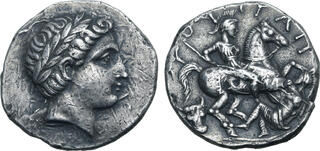| Roma Numismatics Ltd > E-Sale 114 | Auction date: 23 November 2023 |
| Lot number: 115 Price realized: 360 GBP (Approx. 449 USD / 413 EUR) Note: Prices do not include buyer's fees. | Show similar lots on CoinArchives Find similar lots in upcoming auctions on |
| Lot description: Kings of Paeonia, Patraos AR Tetradrachm. Uncertain Paeonian mint (Astibus or Damastion?), circa 335-315 BC. Laureate head of Apollo to right / Warrior on horse rearing to right, spearing enemy who defends with shield and spear; ΠΑΤΡΑΟΥ (retrograde) above, bukranion to lower left. Paeonian Hoard 227 (same dies); cf. SNG ANS 1030-1; Roma 86, 146 (same dies). 12.64g, 24mm, 12h. Good Very Fine. The exact original boundaries of Paeonia, like the early history of its inhabitants, are obscure, but it is known that it was located immediately north of ancient Macedonia; in the Iliad, the Paeonians are reported as allies of the Trojans. During the Persian invasion of Greece the then-powerful Paeonians were conquered by the armies of Darios I and deported from their homelands to Asia. At some point after the Greco-Persian Wars, the Paeonian princedoms coalesced into a kingdom centred in the central and upper reaches of the Axios and Strymon rivers, corresponding with today's northern part of North Macedonia and western Bulgaria, and joined with the Illyrians in attacking the northern areas of the kingdom of Macedon. Philip II reformed the Macedonian armies and put a stop to both the Illyrian and Paeonian raids, and campaigned deep into Paeonian territory, reducing their kingdom (then ruled by Agis) to a vassal state, which led to a process of gradual Hellenisation including the striking of coins with Greek legends. Later, a Paeonian cavalry contingent, led by Ariston (a member of the Paeonian royal house, possibly brother of Patraos and father of the later king Audoleon - see Heckel, W. Prosopography of Alexander's Empire, 2006), was attached to Alexander the Great's army. At the Battle of Gaugamela the Paeonian cavalry were placed with the sarissophoroi on the right flank, the position of honour, and in 331 BC they routed a large force of Persian cavalry near the Tigris; Ariston personally slew the Persian leader Satropates; he then presented Alexander with the Persian's severed head. He asked Alexander for a gold cup as a reward for his feat, and the king publicly saluted him and drank to his health. Estimate: 400 GBP |  |


